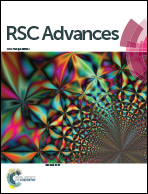Controlled hydrogen generation using interaction of artificial seawater with aluminum plates activated by liquid Ga–In alloy
Abstract
Recent studies have disclosed that liquid metal (Ga–In alloy) can be applied to activate aluminum in electrolytes to generate hydrogen at room temperature. To present a close to reality experimental demonstration of this method and to realize a continuous reaction between an Al plate and seawater, the liquid metal GaIn10 alloy is adopted to directly erode the surface of the Al plate. Then the eroded Al plate is immersed into NaCl solution (simulated seawater) to produce hydrogen. The results indicate that the existence of gallium can accelerate the average H2 production rate. In addition, the average hydrogen generation rate increased from 3 × 10−5 L s−1 to 4.5 × 10−4 L s−1 as the temperature rose from 20 °C to 80 °C when the corrosion area of the Al plates was 1 × 10−4 m2. However, the H2 production first increased and then decreased with the increase of NaCl concentration. The average hydrogen generation effectiveness is 0.71 L g−1 in the aluminum–water reaction in 5% NaCl solution at 20 °C within 20 min. Over the experimental process, the capability of producing hydrogen has a linear relationship with the corrosion area on the surface of the Al plates corroded by the liquid metal. This work suggests good prospects in the future practice of large-scale hydrogen generation using Al and seawater as reaction sources.



 Please wait while we load your content...
Please wait while we load your content...